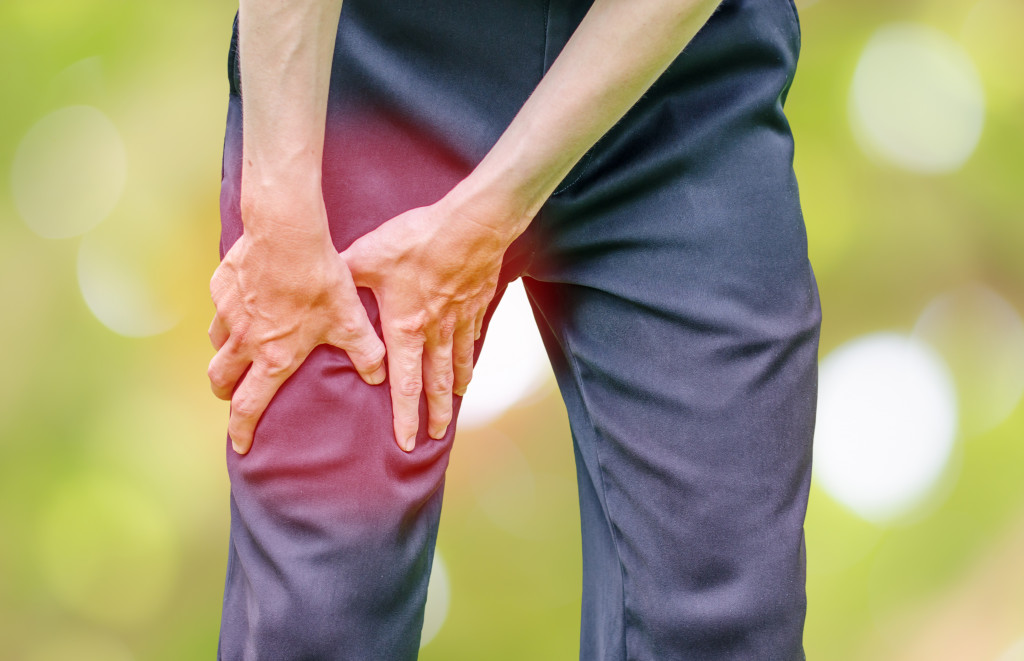- Rest and modify activities to reduce strain on the knee joint.
- Utilize ice and compression therapy to reduce pain and inflammation.
- To target the affected area, perform strengthening exercises, such as leg presses, squats, and calf raises.
- Wear appropriate footwear with cushioning or orthotics for additional support.
- Seek professional treatment for severe cases, such as PRP or HA injections.
Dealing with patellar tendinitis can be challenging, but with the right management strategies, you can effectively manage your symptoms and promote healing. Jumper’s knee or patellar tendinitis is a frequently occurring injury caused by overuse. It impacts the tendon that joins the kneecap (patella) to the shinbone. It often occurs in athletes or individuals involved in repetitive activities that stress the knees. This guide will provide five valuable tips to help you manage and deal with patellar tendinitis.
1. Rest and Modify Activities
One of the key steps in managing patellar tendinitis is allowing your body time to rest and recover. Avoid activities that exacerbate your symptoms, such as jumping or running on hard surfaces. Instead, opt for low-impact exercises, such as swimming or cycling, that put less strain on your knees. If necessary, modify your training or exercise routine to reduce the intensity or frequency of activities that aggravate your symptoms. Gradually reintroduce high-impact activities as your symptoms improve, and always listen to your body’s signals.
2. Ice and Compression

Applying ice and compression can help reduce pain and inflammation associated with patellar tendinitis. Ice the affected area for 15-20 minutes, several times a day, especially after activities that worsen your symptoms. You can use an ice pack or wrap ice in a thin towel to avoid direct contact with the skin. Compression sleeves or braces can also provide support and help reduce swelling. Ensure that the compression is not too tight, as it may restrict blood flow. Remember to consult with a healthcare professional to determine the appropriate duration and frequency of ice and compression therapy.
3. Strengthening and Stretching Exercises
Engaging in specific strengthening and stretching exercises can help improve the strength and flexibility of the muscles around the knee, which can alleviate patellar tendinitis symptoms. Work with a physical therapist or sports medicine professional to develop a tailored exercise program that targets the affected area. It’s important to perform these exercises correctly and gradually increase the intensity to avoid further injury.
Here are some knee strengthening and stretching exercises:
Leg Press
Leg press exercises strengthen the quadriceps, hamstrings, and glutes. To do a leg press, sit on an exercise bench with your feet flat against the platform. Slowly bend your knees and lower the weight until it’s just above your ankles. Then slowly push back up to the starting position. Make sure not to lock your knees at any point during the exercise. Aim for three sets of 10-15 repetitions each set.
Squats

Squats are a great way to strengthen all of the muscles around your knee joint, from your quads and hamstrings to your calves and gluteus maximus. Start in a standing position with your feet shoulder-width apart and your arms out in front of you. Slowly lower yourself as if sitting in a chair, keeping your back straight and looking forward. Then push through your heels to stand back up. Stick with three sets of 8-10 repetitions each set.
Calf Raises
Calf raises are an excellent exercise for strengthening the calf muscles, which can help reduce pain from patellar tendinitis. To do a calf raise, stand on one foot and hold the railing or wall for balance if necessary. Slowly lift your heel off the ground by pushing through your toes until you reach full extension, then slowly lower back down to the starting position. Aim for three sets of 15-20 repetitions each set.
Quadriceps Stretch
Stretching the quadriceps can help reduce knee pain caused by patellar tendinitis. Start standing and grab your right ankle behind you with your right hand. Gently pull your foot towards your buttocks until you feel a stretch in the front of your leg, holding for 20-30 seconds before repeating on the other side. Perform 4-5 stretches on each side, focusing on deep breaths throughout the exercise. This should be done daily to see the best results.
4. Proper Footwear and Orthotics
Wearing appropriate footwear is essential in managing patellar tendinitis. Invest in shoes that provide adequate cushioning and support for your feet and knees. Look for shoes with shock-absorbing soles and good arch support. In some cases, orthotic or custom-made shoe inserts can provide additional support and correct any foot misalignments contributing to knee pain. Consult a podiatrist or orthopedic specialist to determine if orthotics would benefit you.
5. Professional Knee Pain Treatment
In severe or persistent cases of patellar tendinitis, seeking professional knee pain treatment can be beneficial. With a professional treatment, there are various options, such as Platelet-Rich Plasma, hyaluronic acid (HA) injections, and Cortisone injections.
Platelet-Rich Plasma is a form of autologous blood therapy in which the patient’s own platelets are injected into the affected area. The treatment stimulates and speeds up tissue repair, reducing inflammation. Hyaluronic acid injections are artificial joint lubricants that can reduce pain, improve mobility, and delay the need for total knee replacement. Finally, Cortisone injections are a type of anti-inflammatory that can reduce pain and help the knee heal.
In Summary
Managing and dealing with patellar tendinitis requires a comprehensive approach that combines rest, appropriate exercises, proper footwear, and, if necessary, professional treatment. Following these five tips, you can effectively manage your symptoms, promote healing, and gradually return to your desired activities. Everyone’s journey to recovery may differ, so it’s essential to consult with healthcare professionals who can provide personalized guidance and support throughout your patellar tendinitis treatment process.





